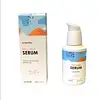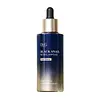What's inside
What's inside
 Key Ingredients
Key Ingredients

 Benefits
Benefits

 Concerns
Concerns

 Ingredients Side-by-side
Ingredients Side-by-side

Water
Skin ConditioningButylene Glycol
HumectantGlycerin
HumectantDimethicone
EmollientCaprylic/Capric Triglyceride
Masking1,2-Hexanediol
Skin ConditioningCetearyl Olivate
Panthenol
Skin ConditioningSorbitan Olivate
EmulsifyingSodium Acrylate/Sodium Acryloyldimethyl Taurate Copolymer
Emulsion StabilisingCeteareth-20
CleansingHelianthus Annuus Seed Oil
EmollientIsohexadecane
EmollientRetinyl Palmitate
Skin ConditioningSodium Hyaluronate
HumectantPolysorbate 80
EmulsifyingTocopheryl Acetate
AntioxidantSimmondsia Chinensis Seed Oil
EmollientArgania Spinosa Kernel Oil
EmollientAllantoin
Skin ConditioningHydrogenated Polyisobutene
EmollientOlea Europaea Fruit Oil
MaskingParfum
MaskingAdenosine
Skin ConditioningGlycine Soja Oil
EmollientEthylhexylglycerin
Skin ConditioningDisodium EDTA
Olea Europaea Husk Oil
Skin ConditioningHydrolyzed Collagen
EmollientTocopherol
AntioxidantBixa Orellana Seed Oil
EmollientAnemarrhena Asphodeloides Root Extract
Skin ConditioningCitronellol
PerfumingLimonene
PerfumingGeraniol
PerfumingLinalool
PerfumingButylphenyl Methylpropional
PerfumingWater, Butylene Glycol, Glycerin, Dimethicone, Caprylic/Capric Triglyceride, 1,2-Hexanediol, Cetearyl Olivate, Panthenol, Sorbitan Olivate, Sodium Acrylate/Sodium Acryloyldimethyl Taurate Copolymer, Ceteareth-20, Helianthus Annuus Seed Oil, Isohexadecane, Retinyl Palmitate, Sodium Hyaluronate, Polysorbate 80, Tocopheryl Acetate, Simmondsia Chinensis Seed Oil, Argania Spinosa Kernel Oil, Allantoin, Hydrogenated Polyisobutene, Olea Europaea Fruit Oil, Parfum, Adenosine, Glycine Soja Oil, Ethylhexylglycerin, Disodium EDTA, Olea Europaea Husk Oil, Hydrolyzed Collagen, Tocopherol, Bixa Orellana Seed Oil, Anemarrhena Asphodeloides Root Extract, Citronellol, Limonene, Geraniol, Linalool, Butylphenyl Methylpropional
Snail Secretion Filtrate 34%
Skin ConditioningWater
Skin ConditioningPropanediol
SolventGlycerin
HumectantC13-16 Isoalkane
SolventGlycereth-26
HumectantNiacinamide
SmoothingPentylene Glycol
Skin ConditioningSqualane
EmollientHeptyl Undecylenate
EmollientPolyglyceryl-3 Distearate
Emulsifying1,2-Hexanediol
Skin ConditioningGlyceryl Stearate
EmollientBetaine
HumectantHydrogenated Polydecene
EmollientHydrogenated Polyisobutene
EmollientUndecane
EmollientHydrogenated Poly(C6-14 Olefin)
EmollientSynthetic Sapphire
Tridecane
PerfumingCaprylyl Glycol
EmollientAcrylates/C10-30 Alkyl Acrylate Crosspolymer
Emulsion StabilisingParfum
MaskingHydrogenated Lecithin
EmulsifyingButylene Glycol
HumectantCetyl Palmitate
EmollientCoco-Caprylate/Caprate
EmollientHydrogenated Olive Oil Unsaponifiables
EmollientMalt Extract
Skin ProtectingSorbitan Olivate
EmulsifyingSorbitan Palmitate
EmulsifyingDioscorea Japonica Root Extract
Skin ConditioningGlyceryl Stearate Citrate
EmollientXanthan Gum
EmulsifyingAdenosine
Skin ConditioningTromethamine
BufferingEthylhexylglycerin
Skin ConditioningCoccinia Indica Fruit Extract
Skin ConditioningEclipta Prostrata Extract
Skin ConditioningHydrolyzed Corn Starch
HumectantDisodium EDTA
Beta-Glucan
Skin ConditioningSodium Polyacrylate
AbsorbentSucrose
HumectantBiosaccharide Gum-1
HumectantPolyether-1
Allantoin
Skin ConditioningCentella Asiatica Extract
CleansingDimethyl Isosorbide
SolventGlyceryl Oleate
EmollientCaprylic/Capric Triglyceride
MaskingTocopherol
AntioxidantLauryl Glucoside
CleansingMyristyl Glucoside
CleansingPolyglyceryl-6 Laurate
EmulsifyingHydroxypinacolone Retinoate
Skin ConditioningMacadamia Ternifolia Seed Oil
EmollientOctyldodecanol
EmollientHydrolyzed Collagen
EmollientHydrolyzed Hyaluronic Acid
HumectantRetinol
Skin ConditioningMaltodextrin
AbsorbentGlycolipids
Skin ConditioningBrassica Campestris Sterols
EmollientPhosphatidylcholine
EmulsifyingCholesterol
EmollientAluminum/Magnesium Hydroxide Stearate
Emulsion StabilisingPentaerythrityl Tetra-Di-T-Butyl Hydroxyhydrocinnamate
AntioxidantZymomonas Ferment Extract
HumectantPearl Extract
AntioxidantHydroxydecyl Ubiquinone
AntioxidantTris(Tetramethylhydroxypiperidinol)Citrate
StabilisingFerulic Acid
AntimicrobialHoney Extract
HumectantPalmitoyl Pentapeptide-4
Skin ConditioningSnail Secretion Filtrate 34%, Water, Propanediol, Glycerin, C13-16 Isoalkane, Glycereth-26, Niacinamide, Pentylene Glycol, Squalane, Heptyl Undecylenate, Polyglyceryl-3 Distearate, 1,2-Hexanediol, Glyceryl Stearate, Betaine, Hydrogenated Polydecene, Hydrogenated Polyisobutene, Undecane, Hydrogenated Poly(C6-14 Olefin), Synthetic Sapphire, Tridecane, Caprylyl Glycol, Acrylates/C10-30 Alkyl Acrylate Crosspolymer, Parfum, Hydrogenated Lecithin, Butylene Glycol, Cetyl Palmitate, Coco-Caprylate/Caprate, Hydrogenated Olive Oil Unsaponifiables, Malt Extract, Sorbitan Olivate, Sorbitan Palmitate, Dioscorea Japonica Root Extract, Glyceryl Stearate Citrate, Xanthan Gum, Adenosine, Tromethamine, Ethylhexylglycerin, Coccinia Indica Fruit Extract, Eclipta Prostrata Extract, Hydrolyzed Corn Starch, Disodium EDTA, Beta-Glucan, Sodium Polyacrylate, Sucrose, Biosaccharide Gum-1, Polyether-1, Allantoin, Centella Asiatica Extract, Dimethyl Isosorbide, Glyceryl Oleate, Caprylic/Capric Triglyceride, Tocopherol, Lauryl Glucoside, Myristyl Glucoside, Polyglyceryl-6 Laurate, Hydroxypinacolone Retinoate, Macadamia Ternifolia Seed Oil, Octyldodecanol, Hydrolyzed Collagen, Hydrolyzed Hyaluronic Acid, Retinol, Maltodextrin, Glycolipids, Brassica Campestris Sterols, Phosphatidylcholine, Cholesterol, Aluminum/Magnesium Hydroxide Stearate, Pentaerythrityl Tetra-Di-T-Butyl Hydroxyhydrocinnamate, Zymomonas Ferment Extract, Pearl Extract, Hydroxydecyl Ubiquinone, Tris(Tetramethylhydroxypiperidinol)Citrate, Ferulic Acid, Honey Extract, Palmitoyl Pentapeptide-4
 Reviews
Reviews

Ingredients Explained
These ingredients are found in both products.
Ingredients higher up in an ingredient list are typically present in a larger amount.
1,2-Hexanediol is a synthetic liquid and another multi-functional powerhouse.
It is a:
- Humectant, drawing moisture into the skin
- Emollient, helping to soften skin
- Solvent, dispersing and stabilizing formulas
- Preservative booster, enhancing the antimicrobial activity of other preservatives
Adenosine is in every living organism. It is one of four components in nucleic acids that helps store our DNA.
Adenosine has many benefits when used. These benefits include hydrating the skin, smoothing skin, and reducing wrinkles. Once applied, adenosine increases collagen production. It also helps with improving firmness and tissue repair.
Studies have found adenosine may also help with wound healing.
In skincare products, Adenosine is usually derived from yeast.
Learn more about AdenosineAllantoin is a soothing ingredient known for its protective and moisturizingg properties. Because of this, it is often added to products with strong active ingredients.
Studies show higher concentrations of this ingredient can promote wound healing.
Though it can be derived from the comfrey plant, allantoin is produced synthetically for cosmetic products to ensure purity.
Learn more about AllantoinButylene Glycol (or BG) is used within cosmetic products for a few different reasons:
Overall, Butylene Glycol is a safe and well-rounded ingredient that works well with other ingredients.
Though this ingredient works well with most skin types, some people with sensitive skin may experience a reaction such as allergic rashes, closed comedones, or itchiness.
Learn more about Butylene GlycolThis ingredient is an emollient, solvent, and texture enhancer. It is considered a skin-softener by helping the skin prevent moisture loss.
It helps thicken a product's formula and makes it easier to spread by dissolving clumping compounds.
Caprylic Triglyceride is made by combining glycerin with coconut oil, forming a clear liquid.
While there is an assumption Caprylic Triglyceride can clog pores due to it being derived from coconut oil, there is no research supporting this.
Learn more about Caprylic/Capric TriglycerideDisodium EDTA plays a role in making products more stable by aiding other preservatives.
It is a chelating agent, meaning it neutralizes metal ions that may be found in a product.
Disodium EDTA is a salt of edetic acid and is found to be safe in cosmetic ingredients.
Learn more about Disodium EDTAEthylhexylglycerin (we can't pronounce this either) is commonly used as a preservative and skin softener. It is derived from glyceryl.
You might see Ethylhexylglycerin often paired with other preservatives such as phenoxyethanol. Ethylhexylglycerin has been found to increase the effectiveness of these other preservatives.
Glycerin is already naturally found in your skin. It helps moisturize and protect your skin.
A study from 2016 found glycerin to be more effective as a humectant than AHAs and hyaluronic acid.
As a humectant, it helps the skin stay hydrated by pulling moisture to your skin. The low molecular weight of glycerin allows it to pull moisture into the deeper layers of your skin.
Hydrated skin improves your skin barrier; Your skin barrier helps protect against irritants and bacteria.
Glycerin has also been found to have antimicrobial and antiviral properties. Due to these properties, glycerin is often used in wound and burn treatments.
In cosmetics, glycerin is usually derived from plants such as soybean or palm. However, it can also be sourced from animals, such as tallow or animal fat.
This ingredient is organic, colorless, odorless, and non-toxic.
Glycerin is the name for this ingredient in American English. British English uses Glycerol/Glycerine.
Learn more about GlycerinHydrogenated Polyisobutene is a synthetic polymer. Polymers are compounds with high molecular weight. Hydrogenated Polyisobutene is an emollient and texture enhancer.
In one study, Hydrogenated Polyisobutene showed better skin hydration levels than Caprylic/Capric Triglyceride. As an emollient, it helps keep your skin soft and hydrated by trapping moisture in.
Hydrogenated Polyisobutene is often used as a mineral oil replacement.
Learn more about Hydrogenated PolyisobuteneHydrolyzed collagen has a misleading name because it is actually a mixture of various proteins/peptides. This ingredient has skin hydrating properties.
Collagen is the most abundant type of structural protein found in your body. In your skin, it is responsible for keeping it firm and youthful.
Hydrolyzed Collagen is created by breaking up proteins into smaller peptide bonds. These peptides act as humectants and emollients.
Humectants are great at holding onto water, keeping skin hydrated. Emollients create a thin barrier on the skin to prevent moisture from escaping.
There is ongoing debate about whether hydrolyzed collagen works because it increases skin hydration. Skin hydration is also linked to elasticity and the appearance of wrinkles.
Collagen or peptide ingredients can be used in the morning or night. They will not increase sun sensitivity, but you should always wear sunscreen during the day.
According to a manufacturer, this ingredient is a great hair conditioner as well.
This ingredient can be extracted from different sources, including:
Vegan collagen is derived from yeast, bacteria, or plant sources. Vegan collagen would go by a different INCI name, such as hydrolyzed soy protein.
The results are varied.
A study from 2021 found hydrolyzed collagen increased elasticity and improved wrinkles in 1,125 participants between age 20 and 70. Another study found increased skin thickness in participants between the ages of 45 to 59.
However, It is difficult to prove that oral collagen will end up working on your skin. Many of the studies using hydrolyzed collagen also add several vitamins and nutrients into the test mixture as well.
Further studies are needed at this time.
Learn more about Hydrolyzed CollagenParfum is a catch-all term for an ingredient or more that is used to give a scent to products.
Also called "fragrance", this ingredient can be a blend of hundreds of chemicals or plant oils. This means every product with "fragrance" or "parfum" in the ingredients list is a different mixture.
For instance, Habanolide is a proprietary trade name for a specific aroma chemical. When used as a fragrance ingredient in cosmetics, most aroma chemicals fall under the broad labeling category of “FRAGRANCE” or “PARFUM” according to EU and US regulations.
The term 'parfum' or 'fragrance' is not regulated in many countries. In many cases, it is up to the brand to define this term.
For instance, many brands choose to label themselves as "fragrance-free" because they are not using synthetic fragrances. However, their products may still contain ingredients such as essential oils that are considered a fragrance by INCI standards.
One example is Calendula flower extract. Calendula is an essential oil that still imparts a scent or 'fragrance'.
Depending on the blend, the ingredients in the mixture can cause allergies and sensitivities on the skin. Some ingredients that are known EU allergens include linalool and citronellol.
Parfum can also be used to mask or cover an unpleasant scent.
The bottom line is: not all fragrances/parfum/ingredients are created equally. If you are worried about fragrances, we recommend taking a closer look at an ingredient. And of course, we always recommend speaking with a professional.
Learn more about ParfumSorbitan Olivate is created from the fatty acids in olive oil and sorbitol.
This ingredient is an oil in water emulsifier. It helps stabilize a product by preventing oils and waters from separating. Sorbitan Olivate also helps hydrate the skin.
Manufacturers sell sorbitan olivate under the name OliveM 1000. OliveM 1000 a multifunctional ingredient. It is self-emulsifying. According to a manufacturer, OliveM 1000 does not disrupt natural skin biome.
Due to its olive oil base, this ingredient may not be fungal-acne safe.
Learn more about Sorbitan OlivateTocopherol (also known as Vitamin E) is a common antioxidant used to help protect the skin from free-radicals and strengthen the skin barrier. It's also fat soluble - this means our skin is great at absorbing it.
Vitamin E also helps keep your natural skin lipids healthy. Your lipid skin barrier naturally consists of lipids, ceramides, and fatty acids. Vitamin E offers extra protection for your skin’s lipid barrier, keeping your skin healthy and nourished.
Another benefit is a bit of UV protection. Vitamin E helps reduce the damage caused by UVB rays. (It should not replace your sunscreen). Combining it with Vitamin C can decrease sunburned cells and hyperpigmentation after UV exposure.
You might have noticed Vitamin E + C often paired together. This is because it is great at stabilizing Vitamin C. Using the two together helps increase the effectiveness of both ingredients.
There are often claims that Vitamin E can reduce/prevent scarring, but these claims haven't been confirmed by scientific research.
Learn more about TocopherolWater. It's the most common cosmetic ingredient of all. You'll usually see it at the top of ingredient lists, meaning that it makes up the largest part of the product.
So why is it so popular? Water most often acts as a solvent - this means that it helps dissolve other ingredients into the formulation.
You'll also recognize water as that liquid we all need to stay alive. If you see this, drink a glass of water. Stay hydrated!
Learn more about Water